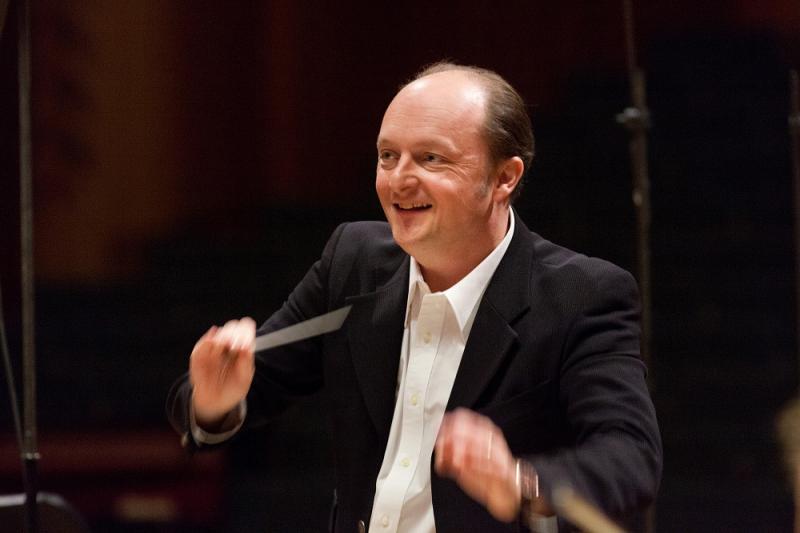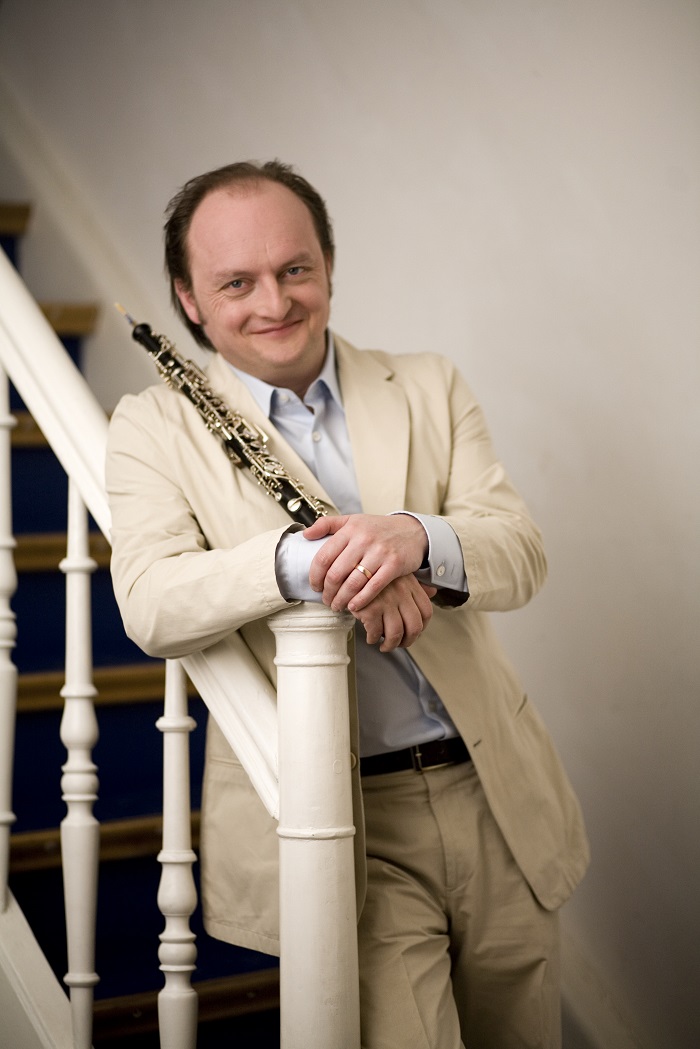CBSO, Leleux, Birmingham Town Hall review - oboe extraordinaire | reviews, news & interviews
CBSO, Leleux, Birmingham Town Hall review - oboe extraordinaire
CBSO, Leleux, Birmingham Town Hall review - oboe extraordinaire
Who needs a baton when you've got an oboe? Charisma triumphs in Haydn and Bizet

There’s always a special atmosphere when the City of Birmingham Symphony Orchestra returns to Birmingham Town Hall, and it’s not just because of the building’s Greek Revival beauty: the gilded sunburst on the ceiling, or the towering, intricately painted mass of the organ, topped with its cameo of Queen Victoria.
No, the main thing is that the Town Hall is small enough, and has sufficiently warm and congenial an acoustic, that even orchestral concerts take on something of a chamber music quality. The balance between woodwind and strings evens itself out, and there’s a physicality to the sound that makes it feel like they’re playing directly to you. And when the space is filled by a conductor and soloist with the outsize charisma and musicianship of the French oboist François Leleux, the effect is doubled. Or maybe trebled; either way, it’s like receiving a big, unexpected Gallic hug.
Leleux directed with nods, oboe waggles and balletic full body swervesAnd yes: Leleux served as both conductor and soloist in the boisterous C major Concerto that’s still attributed to Haydn, though nothing will persuade me that this Labrador puppy of a concerto with its cheerful, foursquare eruptions of trumpets and timpani, is Papa’s original, unretouched work. The point is that with Leleux (pictured below, with oboe, by Uwe Arens) in charge, you didn’t care. Nonchalantly clipping his oboe onto his waistband, he marched a scaled down CBSO crisply through the opening tutti before seizing his instrument and directing the rest of the concerto with a mixture of nods, oboe waggles and balletic full body swerves in the direction of the orchestra.
Leleux’s magnetism is such that the ensemble didn’t once sag or smudge. He sent moulded rococo melodies floating over the orchestra, made passagework slip across the underlying rhythm like melted butter and took aim at the audience before firing out a single, lethal top note. His sound, meanwhile, is – well, are we still allowed to talk about a distinctively French style of woodwind playing? A nasal, slightly citric edge is certainly part of the palette, but it’s just one element of a much richer tonal blend, deglazed and simmered to a succulent essence of oboe. Low notes are gamey and pungent; high notes can be as piercing as a peacock’s cry or as tenderly, sweetly soft as a clarinet.

Leleux followed the "Haydn" (schmaydn) with a transcription of Debussy’s Rapsodie for saxophone: smokey and intensely nostalgic when played on the cor anglais, seriously sensuous when Leleux switched to the oboe to lead the CBSO in a mock-Moorish dance. Amid Debussy’s languishing curves, ensemble wasn’t quite as neat, but by then it didn’t need to be. The entire orchestra was very evidently just enjoying every minute of Leleux’s ride. Then he bounded back on, silenced the audience with a smile, and like a shot from a starting pistol, launched Bizet’s Symphony in C. Once again, this wasn’t a great night to be Gounod at Birmingham Town Hall: the 17 year old Bizet’s symphony is modelled on Gounod’s First, and if you ever want to hear the difference between craftsmanship and genius, listen to the two works side by side. Bizet copies his teacher gesture for gesture, but at every turn, Bizet’s ideas are fresher, livelier, more piquant.
Leleux, understandably, seems to adore it, and with the chamber-sized CBSO by now clearly willing to follow him anywhere, it sparkled with dew. Tempi were enthusiastic; but with rhythms smart and buoyant and every texture ringing clear and bright, the effect was of athleticism rather than with effort – even in that dizzying moto perpetuo finale. Cellos dug energetically into their rustic third movement drones; each entry in the second movement’s featherweight fugue ended with a little skip and the CBSO’s oboe home team of Rainer Gibbons and Emmet Byrne shared their big solo with a suppleness and fantasy that sounded – as they surely intended – like a homage to the evening’s guest star. Leleux brought them straight to their feet as the audience cheered.
The evening had begun with lyrical, clear eyed account of Brahms’s Haydn Variations, which gave early notice of Leleux’s knack for springing a rhythm, and had the CBSO’s woodwinds moving and swaying together like an octet. It ended with Leleux and his cor anglais, and a shortened arrangement of the Largo from Dvorak’s New World Symphony which might have sounded cheesy if the playing of the whole orchestra hadn’t been so luminously expressive. Like all the best encores, it felt like a gift. Leleux introduced it as Goin’ Home. Judging by the way the orchestra beamed as they left the stage, it probably won’t be too long before Leleux is comin’ back.
rating
Explore topics
Share this article
The future of Arts Journalism
You can stop theartsdesk.com closing!
We urgently need financing to survive. Our fundraising drive has thus far raised £49,000 but we need to reach £100,000 or we will be forced to close. Please contribute here: https://gofund.me/c3f6033d
And if you can forward this information to anyone who might assist, we’d be grateful.

Subscribe to theartsdesk.com
Thank you for continuing to read our work on theartsdesk.com. For unlimited access to every article in its entirety, including our archive of more than 15,000 pieces, we're asking for £5 per month or £40 per year. We feel it's a very good deal, and hope you do too.
To take a subscription now simply click here.
And if you're looking for that extra gift for a friend or family member, why not treat them to a theartsdesk.com gift subscription?
more Classical music
 Cho, LSO, Pappano, Barbican review - finely-focused stormy weather
Chameleonic Seong-Jin Cho is a match for the fine-tuning of the LSO’s Chief Conductor
Cho, LSO, Pappano, Barbican review - finely-focused stormy weather
Chameleonic Seong-Jin Cho is a match for the fine-tuning of the LSO’s Chief Conductor
 Classical CDs: Shrouds, silhouettes and superstition
Cello concertos, choral collections and a stunning tribute to a contemporary giant
Classical CDs: Shrouds, silhouettes and superstition
Cello concertos, choral collections and a stunning tribute to a contemporary giant
 Appl, Levickis, Wigmore Hall review - fun to the fore in cabaret and show songs
A relaxed evening of light-hearted fare, with the accordion offering unusual colours
Appl, Levickis, Wigmore Hall review - fun to the fore in cabaret and show songs
A relaxed evening of light-hearted fare, with the accordion offering unusual colours
 Lammermuir Festival 2025, Part 2 review - from the soaringly sublime to the zoologically ridiculous
Bigger than ever, and the quality remains astonishingly high
Lammermuir Festival 2025, Part 2 review - from the soaringly sublime to the zoologically ridiculous
Bigger than ever, and the quality remains astonishingly high
 BBC Proms: Ehnes, Sinfonia of London, Wilson review - aspects of love
Sensuous Ravel, and bittersweet Bernstein, on an amorous evening
BBC Proms: Ehnes, Sinfonia of London, Wilson review - aspects of love
Sensuous Ravel, and bittersweet Bernstein, on an amorous evening
 Presteigne Festival 2025 review - new music is centre stage in the Welsh Marches
Music by 30 living composers, with Eleanor Alberga topping the bill
Presteigne Festival 2025 review - new music is centre stage in the Welsh Marches
Music by 30 living composers, with Eleanor Alberga topping the bill
 Lammermuir Festival 2025 review - music with soul from the heart of East Lothian
Baroque splendour, and chamber-ensemble drama, amid history-haunted lands
Lammermuir Festival 2025 review - music with soul from the heart of East Lothian
Baroque splendour, and chamber-ensemble drama, amid history-haunted lands
 BBC Proms: Steinbacher, RPO, Petrenko / Sternath, BBCSO, Oramo review - double-bill mixed bag
Young pianist shines in Grieg but Bliss’s portentous cantata disappoints
BBC Proms: Steinbacher, RPO, Petrenko / Sternath, BBCSO, Oramo review - double-bill mixed bag
Young pianist shines in Grieg but Bliss’s portentous cantata disappoints
 theartsdesk at the Lahti Sibelius Festival - early epics by the Finnish master in context
Finnish heroes meet their Austro-German counterparts in breathtaking interpretations
theartsdesk at the Lahti Sibelius Festival - early epics by the Finnish master in context
Finnish heroes meet their Austro-German counterparts in breathtaking interpretations
 Classical CDs: Sleigh rides, pancakes and cigars
Two big boxes, plus new music for brass and a pair of clarinet concertos
Classical CDs: Sleigh rides, pancakes and cigars
Two big boxes, plus new music for brass and a pair of clarinet concertos
 Waley-Cohen, Manchester Camerata, Pether, Whitworth Art Gallery, Manchester review - premiere of no ordinary violin concerto
Images of maternal care inspired by Hepworth and played in a gallery setting
Waley-Cohen, Manchester Camerata, Pether, Whitworth Art Gallery, Manchester review - premiere of no ordinary violin concerto
Images of maternal care inspired by Hepworth and played in a gallery setting
 BBC Proms: Barruk, Norwegian Chamber Orchestra, Kuusisto review - vague incantations, precise laments
First-half mix of Sámi songs and string things falters, but Shostakovich scours the soul
BBC Proms: Barruk, Norwegian Chamber Orchestra, Kuusisto review - vague incantations, precise laments
First-half mix of Sámi songs and string things falters, but Shostakovich scours the soul
